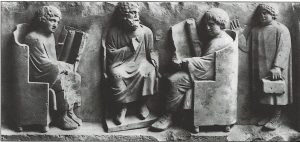The main source for the reconstructions provided in the Reading Ancient Schoolroom is a set of texts called the Colloquia of the Hermeneumata Pseudodositheana. These are bilingual schoolbooks composed at different times and places in the Roman world to help Latin speakers learn Greek and Greek speakers learn Latin. Like many language textbooks today, they include little dialogues and stories of daily life, including scenes involving children going to school and learning Latin, Greek, and other subjects. The Colloquia provide key information on classroom behaviour, teaching practices, the kinds of work students did, and the materials they used. The Colloquia had never been translated into any modern language, or even given a proper edition in their original languages, until Reading’s Professor Eleanor Dickey published her scholarly edition The Colloquia of the Hermeneumata Pseudodositheana (2 volumes, Cambridge 2012 and 2015). Professor Dickey has also produced several versions of the Colloquia designed for a wider audience: a translation with illustrations and commentary (Stories of Daily Life from the Roman World, Cambridge 2017) and a Latin version suitable for modern Latin students (Learning Latin the Ancient Way, Cambridge 2016). What we do in our schoolroom is based primarily on the Colloquia.
Other literary sources we have used include the works of the Roman teacher Quintilian, the Confessions of St. Augustine, the joke book of Philogelos, and the satires of Juvenal. (See e.g. D. A. Russell, Quintilian: The orator’s education: Books 1-2, Loeb Classical Library, 2001; M. Joyal, I. McDougall, and J. C. Yardley, Greek and Roman education: a sourcebook, London 2009; S. F. Bonner, Education in ancient Rome: from the elder Cato to the younger Pliny, Berkeley 1977)
Numerous papyri and ostraca containing school exercises have been discovered from Egypt, most dating to the Roman period. These have been studied especially by Raffaella Cribiore (Writing, teachers, and students in Graeco-Roman Egypt, Atlanta 1996, and Gymnastics of the mind: Greek education in Hellenistic and Roman Egypt, Princeton 2001). They allow detailed insight into the materials used by ancient schoolchildren and the exercises they did; in homage to their place in our reconstruction, our original schoolroom is set in Roman Egypt. The only actual schoolroom ever identified by archaeologists also comes from Roman Egypt; it was found at Trimithis and features white walls with Greek poetry painted on them in red (R. Cribiore and P. Davoli, ‘New Literary Texts from Amheida, Ancient Trimithis (Dakhla Oasis, Egypt)’, Zeitschrift für Papyrologie und Epigraphik 187 (2013): 1–14; R. Cribiore, P. Davoli, and D. M. Ratzan, ‘A teacher’s dipinto from Trimithis (Dakhleh Oasis)’, Journal of Roman Archaeology 21 (2008): 170–91; for photographs of the schoolroom see also figures 120 to 123 of this article). The physical design of our Egyptian schoolroom is modelled on the one in Trimithis, pictured here:

Archaeology has also given us the Edict of Diocletian, a list of prices for the year AD 301 that allows class sizes to be reconstructed; in honour of the Edict our Egyptian school is set in AD 301. Some depictions of schools also survive, including this relief from Trier that served as the model for the costumes used in our schoolroom:
For the Roman Britain version of the schoolroom we use many of the same sources, since there is good reason to suppose that Roman education was broadly similar in different parts of the empire. But whereas in Egypt schoolchildren were mainly Greek speakers, in Britain they would have been either Latin speakers or speakers of the native languages spoken before the Roman conquest (roughly similar to Welsh). In order to facilitate our offering Latin as a second language in the schoolroom, we set our British version soon after the Roman conquest of Britain, when the vast majority of schoolchildren were not native Latin speakers. At that period the general Agricola established Roman schools to help win the native nobles over to Roman rule (Tacitus, Agricola 21.1), and fragments of poetry found at Vindolanda and at Silchester indicate that (as we would expect) Virgil occupied the chief place in the curriculum of British schools, in contrast to Homer in Egypt.
